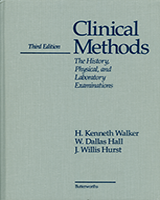NCBI Bookshelf. A service of the National Library of Medicine, National Institutes of Health.
Walker HK, Hall WD, Hurst JW, editors. Clinical Methods: The History, Physical, and Laboratory Examinations. 3rd edition. Boston: Butterworths; 1990.

Clinical Methods: The History, Physical, and Laboratory Examinations. 3rd edition.
Show detailsDefinition
Hoarseness is an abnormal voice characteristic in which the voice has a coarse, breathy quality. Usually it is benign and self-limited, but it may be an early indication of vocal cord carcinoma.
Technique
When presented with a patient with hoarseness, the examiner should determine the duration of hoarseness and the circumstances associated with its onset. One of the most common causes is some traumatic use of the voice such as yelling or shouting at a football game or chronic overuse of the voice as in the case of a professional singer. Smoking history should also be obtained, since it is a traumatic factor as well as a risk factor for the development of malignancies of the aerodigestive tract. An upper respiratory infection with coryza, fever, or cough is another common cause that should be considered. Has the patient had thyroid surgery or other neck surgery in which the vagus or recurrent laryngeal nerve may have been injured? Is there any history of reflux esophagitis or symptoms that might suggest the hoarseness is related to bathing the posterior portion of the larynx in acidic gastric fluids—an under-recognized but common condition? The examiner should inquire about pain or difficulty in swallowing, not only because of proximity of the larynx to the hypopharynx and the esophagus, but because these areas share a common neurologic supply.
Basic Science
The larynx is the guardian of the airway. As such, its function is to provide a passage for air to enter the tracheobronchial tree, to prevent the passage of food, saliva, and other swallowed substances from entering the airway, and to provide a sound source for phonation. The true vocal cords are actually muscles stretched across the top of the trachea and arranged in a V configuration. The major motor nerve supply to the vocal cords is the recurrent laryngeal nerve, which is a branch of the vagus. On both sides, the nerves pass out of the jugular foramen in the base of the skull, down through the neck into the upper chest as the vagus nerve, and then ascend back into the neck in the groove between the esophagus and the trachea as the recurrent laryngeal nerves. In this location they are very vulnerable to injury during thyroid surgery. On inspiration, the angle between the cords widens as the cords abduct, and the angle decreases as the cords adduct during phonation and swallowing. Sound is created by vibration of the free edge of the cords, which occurs as expired air is forced through adducted cords.
Repeated forceful vocal cord adduction with high-velocity expiratory airflow, which occurs with shouting, can be very injurious to the vocal cords. Hoarseness may develop because of generalized swelling or by producing a small intramucosal hematoma at the point of maximum amplitude of vibration on the free edge of the cord. This hematoma can become organized and go on to form a small nodule, the so-called singer's nodule. Anything that interferes with the vibration of the free edge of the cord or that produces incomplete closure of the glottis can cause hoarseness. This includes benign vocal cord lesions such as polyps or papillomas, malignant lesions such as carcinoma, or neurologic dysfunction or injury of the vagus or, more specifically, the recurrent laryngeal nerve.
Clinical Significance
Most hoarseness results from benign causes such as acute laryngitis and is transient and self-limited. The clinical importance of hoarseness is that it may be an early sign of a vocal cord carcinoma, a potentially curable lesion. Any patient with hoarseness of greater than 2 weeks" duration should be examined via indirect laryngoscopy by mirror or by direct fiberoptic examination, both of which are office procedures. If a vocal cord lesion is found, then the patient may require direct laryngoscopy and biopsy.
References
- Paparella M, Shumrick D, eds. Otolaryngology: head and neck. Philadelphia: W.B. Saunders,1980;3:2447–2527.
- Saunders WH. The larynx. Ciba Clin Symp. 1964;16:67–99. [PubMed: 14194312]
- PubMedLinks to PubMed
- Review Hoarseness in adults.[Am Fam Physician. 2009]Review Hoarseness in adults.Feierabend RH, Shahram MN. Am Fam Physician. 2009 Aug 15; 80(4):363-70.
- Vocal function following carbon dioxide laser surgery for glottic carcinoma.[Ann Otol Rhinol Laryngol. 1985]Vocal function following carbon dioxide laser surgery for glottic carcinoma.Hirano M, Hirade Y, Kawasaki H. Ann Otol Rhinol Laryngol. 1985 May-Jun; 94(3):232-5.
- Voice quality after treatment of early vocal cord cancer: a randomized trial comparing laser surgery with radiation therapy.[Int J Radiat Oncol Biol Phys. ...]Voice quality after treatment of early vocal cord cancer: a randomized trial comparing laser surgery with radiation therapy.Aaltonen LM, Rautiainen N, Sellman J, Saarilahti K, Mäkitie A, Rihkanen H, Laranne J, Kleemola L, Wigren T, Sala E, et al. Int J Radiat Oncol Biol Phys. 2014 Oct 1; 90(2):255-60.
- Cause of hoarseness in elderly patients.[Otolaryngol Head Neck Surg. 1998]Cause of hoarseness in elderly patients.Lundy DS, Silva C, Casiano RR, Lu FL, Xue JW. Otolaryngol Head Neck Surg. 1998 Apr; 118(4):481-5.
- Review Hoarseness-causes and treatments.[Dtsch Arztebl Int. 2015]Review Hoarseness-causes and treatments.Reiter R, Hoffmann TK, Pickhard A, Brosch S. Dtsch Arztebl Int. 2015 May 8; 112(19):329-37.
- Hoarseness - Clinical MethodsHoarseness - Clinical Methods
Your browsing activity is empty.
Activity recording is turned off.
See more...